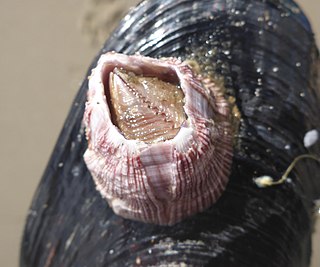
Barnacles are a type of arthropod constituting the subclass Cirripedia in the subphylum Crustacea, and are hence related to crabs and lobsters. Barnacles are exclusively marine, and tend to live in shallow and tidal waters, typically in erosive settings. Around 1,000 barnacle species are currently known.

Johannes Japetus Smith Steenstrup FRS(For) HFRSE was a Danish zoologist, biologist, and professor.

The Balanidae comprise a family of barnacles of the order Balanomorpha. As a result of research published in 2021 by Chan et al., the members of the family Archaeobalanidae were merged with this family.

The Chthamalidae are a family of chthamaloid barnacles, living entirely in intertidal/subtidal habitats, characterized by a primary shell wall of eight, six, or four plates, lacking imbricating plate whorls, and either membraneous or more rarely calcareous basis. They are not found below immediate subtidal habitats, and more likely are found in the highest tier of shallow-water barnacle fauna. They can be found in the most rigorous wave-washed locations, and some species are found in the surf zone above high tide mark, only receiving water from wave action at high tide.

This is a list of the writings of Charles Darwin.

Acorn barnacle and acorn shell are vernacular names for certain types of stalkless barnacles, generally excluding stalked or gooseneck barnacles. As adults they are typically cone-shaped, symmetrical, and attached to rocks or other fixed objects in the ocean. Members of the barnacle order Balanomorpha are often called acorn barnacles.

Whale barnacles are species of acorn barnacle that belong to the family Coronulidae. They typically attach to baleen whales, and sometimes settle on toothed whales. The whale barnacles diverged from the turtle barnacles about three million years ago.

Balanus nubilus, commonly called the giant acorn barnacle, is the world's largest barnacle, reaching a diameter of 15 cm (6 in) and a height of up to 30 cm (12 in), and containing the largest known muscle fibres.

Amphibalanus improvisus, the bay barnacle, European acorn barnacle, is a species of acorn barnacle in the family Balanidae.
Megabalanus stultus is a species of barnacle first described by Charles Darwin in 1854. It lives on fire corals of the genus Millepora in the Atlantic Ocean from Florida to southern Brazil.

Notochthamalus scabrosus, the only species in the genus Notochthamalus, is a species of barnacle found along the south-western and south-eastern coasts of South America, from Peru to the Falkland Islands. The species is found almost exclusively higher in the intertidal zone than the mussel Perumytilus, often codistributed with the confamilial barnacle Jehlius cirratus and Balanus flosculus.

Megabalanus tintinnabulum is a species of large barnacle in the family Balanidae. It is the type species of the genus. The specific name comes from the Latin tintinnabulum meaning a handbell and probably refers to the fact that small groups of barnacles resemble clusters of miniature bells.

Megabalanus coccopoma, the titan acorn barnacle, is a tropical species of barnacle first described by Charles Darwin in 1854. Its native range is the Pacific coasts of South and Central America but it is extending its range to other parts of the world.

Catomerus is a monotypic genus of intertidal/shallow water acorn barnacle that is found in warm temperate waters of Australia. The genus and species is very easily identified by whorls of small plates surrounding the base of the primary shell wall; no other shoreline barnacle species in the Southern Hemisphere has that feature. This species is considered to be a relic, as these plates are found only in primitive living lineages of acorn barnacles or in older fossil species. The fact that this is an intertidal species is unusual, because living primitive relic species are often found in more isolated habitats such as deep ocean basins and abyssal hydrothermal vents.
Catophragmus is the originally named genus of the family Catophragmidae. At present, it is monotypical. It is a shallow water acorn barnacle of the Tropical Western Atlantic and Caribbean characterized by small accessory imbricating plates surrounding the base of the shell wall.
Chamaesipho is a genus of four-plated notochthamaline barnacles in the Pacific Ocean limited to Australian/New Zealand temperate waters. They are intertidal in preference, and tend to form crowded columnar colonies. They can be identified in the field by having a four-plated wall, an unfused rostrum, and narrow opercular plates. Elminius, which also inhabits the same area, has four plates in its shell wall. However, in Elminius, the rostrum and rostrolatera are fused completely, and the compound rostrum receives the alae of the adjacent carinolaterals. In Chamaesipho, the unfused rostrum bears alae, and closely resembles the carina in appearance.

Coronula diadema is a species of whale barnacle that lives on the skin of humpback whales and certain other species of whale. This species was first described by Carl Linnaeus in the 1767 12th edition of his Systema Naturae.

Megabalanus californicus, the California barnacle, is a species of large barnacle in the family Balanidae. It is native to rocky coasts in the Eastern Pacific Ocean from North California to the Gulf of California.

Notomegabalanus is a genus of acorn barnacles in the family Balanidae. There are about 12 described species in Notomegabalanus.
















